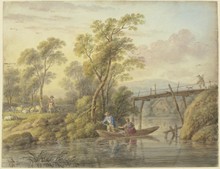Opp Amaryllis!
| "Opp Amaryllis!" | |
|---|---|
| Art song | |
 Sheet music | |
| English | Up, Amaryllis! |
| Written | 1773 |
| Text | poem by Carl Michael Bellman |
| Language | Swedish |
| Published | 1791 in Fredman's Songs |
| Scoring | voice and cittern |
Opp Amaryllis! (Up, Amaryllis!) is one of the Swedish poet and performer
Context
The eponymous character Amaryllis is taken from classical tales. In Ancient Greek literature, Theocritus's Idylls portray a goatherd singing a serenade outside the cave of the nymph Amaryllis.[10] In Ancient Roman literature, Amaryllis was a heroine in Virgil's Eclogues, a suite of pastoral poems.[11]
Song
Melody and verse form
The song is in 3
4 time and is marked Menuetto. It has 4 verses, each consisting of 11 lines; lines 2-7 are short. The rhyming pattern of each verse is AA-B-CCC-B-DDD-B. No source has been identified for the melody, which may well have been composed by Bellman himself.[12]
Lyrics

The song, headed "Om fiskafänget" ("About catching fish"), is dated 1773, and was written for Bellman's opera Fiskarena.[13][12] The song invites the sleeping nymph, in reality Wilhelmina Norman (who Bellman courted in the summer of 1773), to awaken and come fishing.[14][13] The waterways, too, are Swedish, with familiar fish like pike.[15]
| Carl Michael Bellman, 1791[16] | Charles Wharton Stork, 1917[17] | Hendrik Willem Van Loon, 1939[18]
|
Paul Britten Austin, 1977[19] |
|---|---|---|---|
Kom nu och fiska, noten är bunden, |
Let's go a-fishing—nets are all spread now— |
Let's go a-fishing, nets are now spread, oh, |
Come, come a-fishing! Ready our rod is; |
Reception and legacy

The Bellman scholar
Bellman's biographer Paul Britten Austin describes the song as "one of his most delightful, and for many years [it] was far and away the most popular. It goes to a charming air."[20] "Opp Amaryllis!" was recorded in 1924 by Folke Andersson and Edvard Andreasson for HMV.[21] More recently, the song has been recorded many times; it was among the Bellman songs recorded in 1960 by Roland Bengtsson and Folke Sällström,[22] and in 1988 by the actor Mikael Samuelson.[23] The song was recorded in English by Martin Best in 1995.[24]
References
- ^ Bellman 1790.
- ^ Bellman Society. Archived from the originalon 10 August 2015. Retrieved 25 April 2015.
- ^ "Bellman in Mariefred". The Royal Palaces [of Sweden]. Archived from the original on 21 June 2022. Retrieved 19 September 2022.
- ISBN 978-0131369207.
- ^ Britten Austin 1967, pp. 60–61.
- ^ Britten Austin 1967, p. 39.
- ^ Britten Austin 1967, pp. 81–83, 108.
- ^ Britten Austin 1967, pp. 71–72 "In a tissue of dramatic antitheses—furious realism and graceful elegance, details of low-life and mythological embellishments, emotional immediacy and ironic detachment, humour and melancholy—the poet presents what might be called a fragmentary chronicle of the seedy fringe of Stockholm life in the 'sixties.".
- ^ Britten Austin 1967, p. 63.
- ^ "Theocritus, Idylls". Loeb Classical Library. Retrieved 29 December 2020.
- ^ Virgil. "Virgil's Eclogues". virgil.org. Retrieved 29 December 2020.
- ^ a b Bellman 1984, pp. 78, 134.
- ^ a b "N:o 31 (Kommentar tab)". Bellman.net (in Swedish). Retrieved 2 February 2022.
- ^ Bellman 1989, pp. 209–212.
- ^ a b Lönnroth 2005, pp. 120–124.
- ^ Bellman 1989, p. 209.
- ^ Stork 1917, p. 8.
- ^ Van Loon & Castagnetta 1939, pp. 83–84.
- ^ Britten Austin 1977, p. 121.
- ^ Britten Austin 1967, p. 103.
- ^ "Opp Amaryllis by Folke Andersson, Edvard Andreasson". SecondHandSongs. Retrieved 27 June 2021.
- ^ Bengtsson, Roland; Sällström, Folke. "Bellman, C. M.: Fredmans sånger (excerpts) (Sällström, Bengtsson)". Naxos. Retrieved 27 June 2021.
- ^ Samuelson, Mikael. "Music of Carl Michael Bellman". AllMusic. Retrieved 27 June 2021.
- ^ "To Carl Michael with love : Martin Best sings the songs and epistles of Sweden's 18th century songwriter / Carl Michael Bellman Solna : EMI, cop. 1995". Svensk MedieDatabas. Retrieved 27 June 2021.
Sources
- Bellman, Carl Michael (1790). Fredmans epistlar. Stockholm: By Royal Privilege.
- ISBN 978-3-932759-00-0.
- Britten Austin, Paul (1977). Fredman's Epistles and Songs. Stockholm: Reuter and Reuter. OCLC 5059758.
- ISBN 91-7448-742-6.
- ISBN 91-7736-059-1. (with facsimiles of sheet music from first editions in 1790, 1791)
- OCLC 61881374.
- Stork, Charles Wharton (1917). Anthology of Swedish Lyrics, 1750-1915. New York: The American-Scandinavian Foundation.
- Van Loon, Hendrik Willem; Castagnetta, Grace (1939). The Last of the Troubadours. New York: Simon & Schuster.
External links
- Text of Song 31 at Bellman.net


